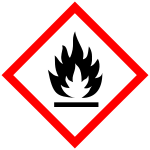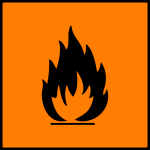Highly flammable substances


According to Directive 67/548 / EEC, highly flammable substances were hazardous substances with the following properties:
- Substances that heat up in the air at room temperature without the use of energy and can ultimately ignite,
- Solids which can easily ignite when exposed to an ignition source for a short time and which can continue to burn or glow after they have been removed,
- Liquids that have a low flash point (below 21 ° C),
- Substances which, in contact with water or moist air, develop extremely flammable gases (at least 1 l / kg / h)
This directive has now been repealed and replaced by the Globally Harmonized System for Classification and Labeling of Chemicals (GHS for short) and replaced on June 1, 2015 by Regulation No. 1272/2008 (CLP Regulation) . This means that the hazard symbol has also been replaced by the corresponding GHS pictogram for flammable substances , which summarizes highly flammable, highly flammable and flammable substances.
According to the definition in the publication VdS 2046, Gesamtverband der Deutschen Versicherungswirtschaft e. V. (GDV) are to be classified as "easily flammable" those flammable substances that are exposed to the flame of a match for 10 seconds, continue to burn or continue to glow after the ignition source has been removed. This can include: hay, straw, straw dust, flour, wood shavings, loose wood wool, magnesium shavings, sticks, loose paper, cotton and cellulose fibers, plastics, varnishes, solvents and oils.
See also
Footnotes
- ↑ REACH: REGULATION (EC) No. 1272/2008 OF THE EUROPEAN PARLIAMENT AND OF THE COUNCIL of December 16, 2008 ( Memento of the original of June 14, 2016 in the Internet Archive ) Info: The archive link was inserted automatically and has not yet been checked. Please check the original and archive link according to the instructions and then remove this notice. , accessed September 30, 2016.
- ↑ Safety regulations for electrical systems up to 1000 volts. (PDF; 63 kB) In: VdS 2046. VdS Verlag, January 2008, accessed on May 7, 2012 .